肥胖和代谢综合征英文
内科学7版第五章肥胖症

内科学7版第五章肥胖症第五章肥胖症肥胖症(obesity)指体内脂肪堆积过多和(或)分布异常、体重增加,是包括遗传和环境因素在内的多种因素相互作用所引起的慢性代谢性疾病。
超重和肥胖症在一些发达国家和地区人群中的患病情况已达到流行程度。
据估计,在西方国家成年人中,约有半数人超重和肥胖。
我国肥胖症患病率也迅速上升,据《中国居民营养与健康现状(2004年)》中报道,我国成人超重率为22.8%,肥胖率为7.1%,估计患病人数分别为2.0亿和6000多万。
肥胖症作为代谢综合征的主要组分之一,与多种疾病如2型糖尿病、血脂异常、高血压、冠心病、卒中和某些癌症密切相关。
肥胖症及其相关疾病可损害患者身心健康,使生活质量下降,预期寿命缩短,成为重要的世界性健康问题之一。
我国卫生部疾病控制司已于2003年制订了《中国成人超重和肥胖症预防控制指南(试用)》。
肥胖可作为某些疾病的临床表现之一,称为继发性肥胖症,约占肥胖症的1%。
【病因和发病机制】(一)能量平衡和体重调节体内存在一套精细的监测及调控系统以维持体重稳定,称为“调定点(set-point)”。
由于体重调定点的存在,短期体重增加或减少将自动代偿,体重倾向于恢复到调定点水平。
体重受神经系统和内分泌系统双重调节,最终影响能量摄取和消耗的效应器官而发挥作用。
中枢神经系统控制饥饿感和食欲、影响能量消耗速率、调节与能量贮存有关激素的分泌,在能量内环境稳定及体重调节中发挥重要作用。
下丘脑是控制能量代谢最重要部位,影响下丘脑食欲中枢的信号包括传人神经信号(以迷走神经最为重要,传人来自内脏的信息,如胃肠膨胀程度等)、激素信号(如瘦素、胰岛素、各种肠肽等)以及代谢产物(如葡萄糖)等。
上述信号传人中枢神经系统,经过整合后通过神经-体液途径传出信号到靶器官,以保持个体近期或长期能量平衡。
体内参与调节摄食行为的活性物质包括:①减少摄食的因子:β肾上腺素能受体、多巴胺、血清素、胰升糖素样多肽-1(GLP-l)和瘦素等。
代谢综合征

代谢综合征代谢综合征代谢综合征(metablic syndrome,MS)是一类以高血糖、肥胖、血脂异常和高血压等集簇存在为标志的临床综合征。
其临床重要性在于与之相关的高危心血管疾病和糖尿病等。
中心性肥胖和胰岛素抵抗是被公认的重要致病因素。
目前关于MS及其各个组分的发病机理复杂,尚没有被充分认识。
可能机制有糖脂代谢和胰岛素生物效应、作用途径及信号转导异常,以及下丘脑-垂体-肾上腺轴调控异常、神经体液调节异常、炎症反应或氧化应激等。
代谢综合征目前包括1999年世界卫生组织 (World Health Organization,WHO)指南、2001年美国胆固醇教育计划成人治疗专家组第三次报告(Third Report of the National Cholesterol Education Program Expert Panel on Detection, Evaluation, and Treatment of High Blood Cholesterol in Adults,NCEP-ATPⅢ)指南、2004年中国糖尿病学会指南、2005年国际糖尿病联盟(International Diabetes Federation,IDF)指南、2007年中国成人血脂异常防治指南及2007年欧洲心脏病学学术大会(European Society of Cardiology,ESC)指南所制定的标准。
中医无代谢综合征病名,可根据其临床表现肥胖、眩晕、心悸等,归入中医学肥气、腹满、消渴、眩晕、胸痹、痰饮、郁证等病症范畴讨论。
本诊疗规范主要应用于2型糖尿病合并代谢综合征。
1 病因病机1.1 西医认识1.病因(1)肥胖:肥胖是代谢综合征的一个重要特征,包括全身性肥胖和中心性肥胖,是代谢综合征发病的始动因子。
脂肪组织是一重要的内分泌器官,可分泌大量促炎或炎症因子,主要分泌有瘦素、脂联素、抵抗素、肿瘤坏死因子-α(tumornecrosis factor-a,TNF-a)、白介素(interleukin,IL)等,均与代谢综合征、胰岛素抵抗有密切关系。
医疗健康有关的英语词汇

医疗健康有关的英语词汇一、常见疾病词汇1. Diabetes (糖尿病)2. Hypertension (高血压)3. Asthma (哮喘)4. Cancer (癌症)5. Heart Disease (心脏病)6. Stroke (中风)7. Arthritis (关节炎)8. Obesity (肥胖症)9. Allergy (过敏)10. Depression (抑郁症)二、身体部位词汇1. Heart (心脏)2. Brain (大脑)3. Liver (肝脏)4. Lung (肺)5. Kidney (肾脏)6. Stomach (胃)7. Intestine (肠道)8. Bone (骨骼)9. Muscle (肌肉)10. Skin (皮肤)三、医疗检查与治疗词汇1. Xray (X光检查)2. CT Scan (CT扫描)3. MRI (磁共振成像)4. Ultrasound (超声波检查)5. Blood Test (血液检查)6. Urine Test (尿液检查)7. Physical Examination (体检)8. Surgery (手术)9. Medication (药物治疗)10. Therapy (治疗)四、医疗人员与设施词汇1. Doctor (医生)2. Nurse (护士)3. Surgeon (外科医生)4. Physician (内科医生)5. Dentist (牙医)6. Hospital (医院)7. Clinic (诊所)8. Pharmacy (药房)9. Ambulance (救护车)10. Health Insurance (医疗保险)五、健康生活习惯词汇1. Exercise (锻炼)2. Diet (饮食)3. Sleep (睡眠)4. Relaxation (放松)5. Meditation (冥想)6. Hydration (补水)7. Quit Smoking (戒烟)8. Limit Alcohol (限酒)9. Preventive Measures (预防措施)10. Healthy Lifestyle (健康生活方式)六、症状描述词汇1. Fever (发烧)2. Cough (咳嗽)3. Sore Throat (喉咙痛)4. Headache (头痛)5. Nausea (恶心)6. Vomiting (呕吐)7. Diarrhea (腹泻)8. Constipation (便秘)9. Fatigue (疲劳)10. Pain (疼痛)七、药物与治疗用品词汇1. Painkiller (止痛药)2. Antibiotic (抗生素)3. Antihistamine (抗组胺药)4. Insulin (胰岛素)5. Aspirin (阿司匹林)6. Tablet (药片)7. Capsule (胶囊)8. Syrup (糖浆)9. Injection (注射)10. Bandage (绷带)八、健康与福祉相关词汇1. Wellness (健康)2. Wellbeing (福祉)3. Prevention (预防)4. Recovery (恢复)5. Rehabilitation (康复)6. Immunization (免疫)7. Vaccination (接种疫苗)8. Nutrition (营养)9. Hygiene (卫生)10. Stress Management (压力管理)九、医疗专业术语词汇1. Appendicitis (阑尾炎)2. Appendectomy (阑尾切除手术)3. Hypoglycemia (低血糖)4. Hyperglycemia (高血糖)5. Hypotension (低血压)6. Hypertrophy (肥大)7. Myocardial Infarction (心肌梗死)8. Osteoporosis (骨质疏松)9. Parkinson's Disease (帕金森病)10. Alzheimer's Disease (阿尔茨海默病)十、医疗保险与费用词汇1. Premium (保险费)2. Deductible (免赔额)3. Copayment (共同支付)4. Coverage (保险覆盖范围)5. Claim (理赔)6. Policy (保险单)7. Provider (医疗服务提供者)8. Outofpocket (自付费用)9. Reimbursement (报销)10. Preexisting Condition (既有疾病)十一、心理健康相关词汇1.心理学 Psychology2.心理咨询 Counseling3.心理治疗 Psychotherapy4.情绪波动 Emotional Fluctuations5.焦虑 Anxiety6.恐慌症 Panic Attack7.强迫症 ObsessiveCompulsive Disorder (OCD)8.创伤后应激障碍 PostTraumatic Stress Disorder (PTSD)9.心理韧性 Psychological Resilience10.自我认知 SelfAwareness十二、替代疗法与补充医学词汇1.针灸 Acupuncture2.按摩 Massage Therapy3.瑜伽 Yoga4.冥想 Meditation5.草药 Herbal Medicine6.顺势疗法 Homeopathy7.营养补充剂 Dietary Supplements8.脊椎按摩 Chiropractic9.能量疗法 Energy Healing10.整骨疗法 Osteopathy十三、医疗程序与手术术语词汇1.活检 Biopsy2.透析 Dialysis3.放疗 Radiation Therapy4.化疗 Chemotherapy5.激光手术 Laser Surgery6.微创手术 Minimally Invasive Surgery7.器官移植 Organ Transplant8.冠状动脉搭桥手术 Coronary Artery Bypass Graft (CABG)9.人工关节置换 Total Joint Replacement10.腹腔镜手术 Laparoscopic Surgery 十四、孕妇与婴儿健康词汇1.妊娠 Pregnancy2.产前检查 Prenatal Care3.分娩 Labor and Delivery4.哺乳 Breastfeeding5.新生儿护理 Newborn Care6.儿科 Pediatrics7.免疫接种 Immunization Schedule8.婴儿食品 Ba Food9.儿童成长发育 Child Development10.产后护理 Postpartum Care十五、健康饮食与营养词汇1.卡路里 Calorie2.蛋白质 Protein3.碳水化合物 Carbohydrates4.脂肪 Fats5.维生素 Vitamins6.矿物质 Minerals7.膳食纤维 Dietary Fiber8.均衡饮食 Balanced Diet9.低脂饮食 LowFat Diet10.素食主义 Vegetarianism通过这些词汇的积累,你将能够更好地理解和沟通医疗健康相关的信息,无论是在专业领域还是日常生活中。
代谢综合征

代谢综合征【定义】儿童青少年代谢综合(metabolic syndrome,MetS)是与生活方式密切相关,以肥胖、高血糖、高血压及血脂异常等集结发病为特征的一组临床症候群。
【诊断】一、≥10岁儿童青少年中心性肥胖:腰围≥同年龄同性别儿腰围的90百分位值(P90)。
为儿童青少年MetS 基本和必备条件,同时具备至少下列2项:(1)高血糖:①空腹血糖受损(IFG):空腹血糖≥5.6mmol/L;②或糖耐量受损(IGT):口服葡萄糖耐量试验2h血糖≥7.8mmol/L,但<11.1mmol/L;③或2型糖尿病。
(2)高血压:收缩压≥同年龄同性别儿童血压的P95或舒张压≥同年龄同性别儿童血压的P95。
(3)低高密度脂蛋白胆固醇(HDL-C<1.03mmoL)或高非高密度脂蛋白胆固醇(nonHDL-C≥3.76mmol/L)(4)高甘油三酯(TG≥1.47mmol/L)。
中心性肥胖的简易识别方法:建议应用腰围身高比(waist to-height ratio,WHtR)作为筛查指标。
WHtR切点:男童0.48,女童0.46。
高血压的快速识别方法:收缩压≥130mmHg(1mmHg=0.133kPa),舒张压≥85mmHg 以上两方法主要用于中心性肥胖和高血压的快速筛查,如需明确诊断及研究.仍需查腰围和高血压的各年龄段百分位值表。
二、6≤年龄<10(岁)儿童6≤年龄<10(岁)年龄段儿童的生理特征处于快速变化中,不宜轻易诊断MetS。
然而,近期临床研究发现,该组肥胖儿童已经暴露多项代谢异常,故提出CVD危险因素并予以明确界定:1、肥胖:体块指数(BMI)≥同年龄同性别儿童BMI的P95或腰围≥同年龄同性别儿童腰围的P95。
2、高血压:血压≥同年龄同性别儿童血压的P95。
快速识别:收缩压≥120mmHg或舒张压≥80mmHg。
3、脂代谢紊乱:①低HDL-C(<1.03mmol/L);②高non-HDL-C(≥3.76mmol/L);③高TG(≥1.47mmol/L)。
bmi英语范围
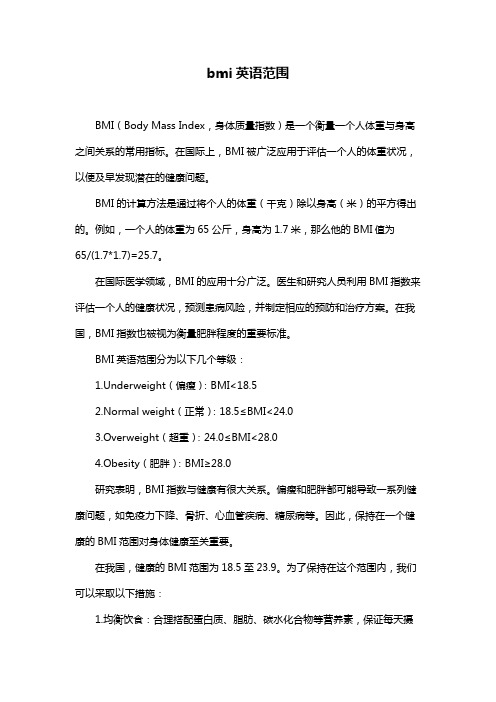
bmi英语范围BMI(Body Mass Index,身体质量指数)是一个衡量一个人体重与身高之间关系的常用指标。
在国际上,BMI被广泛应用于评估一个人的体重状况,以便及早发现潜在的健康问题。
BMI的计算方法是通过将个人的体重(千克)除以身高(米)的平方得出的。
例如,一个人的体重为65公斤,身高为1.7米,那么他的BMI值为65/(1.7*1.7)=25.7。
在国际医学领域,BMI的应用十分广泛。
医生和研究人员利用BMI指数来评估一个人的健康状况,预测患病风险,并制定相应的预防和治疗方案。
在我国,BMI指数也被视为衡量肥胖程度的重要标准。
BMI英语范围分为以下几个等级:1.Underweight(偏瘦):BMI<18.52.Normal weight(正常):18.5≤BMI<24.03.Overweight(超重):24.0≤BMI<28.04.Obesity(肥胖):BMI≥28.0研究表明,BMI指数与健康有很大关系。
偏瘦和肥胖都可能导致一系列健康问题,如免疫力下降、骨折、心血管疾病、糖尿病等。
因此,保持在一个健康的BMI范围对身体健康至关重要。
在我国,健康的BMI范围为18.5至23.9。
为了保持在这个范围内,我们可以采取以下措施:1.均衡饮食:合理搭配蛋白质、脂肪、碳水化合物等营养素,保证每天摄入足够的能量和营养。
2.规律运动:每周至少进行150分钟的中等强度运动,如快走、慢跑等。
3.控制热量摄入:避免暴饮暴食,尤其是高热量、高脂肪的食物。
4.养成良好的生活习惯:保持作息规律,避免熬夜,戒烟限酒。
总之,了解自己的BMI指数,并根据指数调整生活方式,对预防和控制肥胖及相关疾病具有重要意义。
代谢综合征医学_2022年学习资料

代谢综合征代谢综合征PPT医学课件CONTENTS-MS的概述-MS的诊断标准-MS的治疗方法-MS的预防措施、-MS的概述-MS一一“富贵病”MS的概述-一MS的概念-卒代谢综合征-metabolic syndrome,MS-概念:由于胰岛素抵抗1引起的高胰岛素血症进而导-致的一组可致动粥样硬化的代谢性疾病的总称,它包括肥胖、-脂质代谢异常、高血压、2型糖尿病等。
MS的概述-什么是胰岛素抵抗IR!-安机体对胰岛素敏感性下降-卒胰岛素降血糖的能力降低-安身体组织对葡萄糖的利用障碍-糖尿病、高血压、血脂异常、肥根本原因:是R。
-IR是代谢综合征MS的中心环节。
一、MS的概述-一MS的概念-西医学名-代谢综合征-高血压-高体重-英文名称-metabolic syndrome-主要症状-代谢紊乱-主要病因-活方式-发病部位-周身-多发群体-肥胖-血脂异常-高血糖-传染性-无传染性-所属科室-内科内分泌科MS的概述-一MS的概念-MS概念的演变-②1980年,代谢综合征-②1988年,X综合征、Reaven综合征-Hanef Id-②1991年,胰素抵抗综合征-DeFronzo-②1998年,代谢综合征MS-WHO-②1999年,WH0;2001年NCEP-ATPI川和2005年1DF给出M定义后,-MS的命名被学术界广泛接受。
MS的概述-二MS的流行病学现状-慢性代谢性疾病发病率逐年升高,而MS作为典型的慢性代谢性-疾病越来越受关注。
-卒在全球范围内,其发病率已达13. 1%。
-女在我国,其发病率为14-18%。
MS的概述-为顺应国内外加强代谢-病防控的迫切需求,以郭姣-业委员会成立ナ会暨第三届岭南代谢-教授为首的研究团队长期致-ases,and the "Lingnan Interr-rum of Meta-eases,World Federation o-力于加强代谢性疾病研究的-中日健康学木今会因-合作和交流,牵头成立了国-t Sino-Japan Health-15年11月27-28日中-内首个代谢病中西医结合专-27h28h,201.Guan5-业委员会-广东省中西医结-联合会-东省代谢-合学会代谢病专业委员会,-旨在通过这一平台汇集全球-资源,协作攻关,攻克代谢-病综合防控一世界难题。
代谢综合征(MS)解析

二、MS的诊断标准
2007年中国成人血脂异常防治指南
符合以下3项者即可诊断为代谢综合征。 1. 腹部肥胖:男性腰围>90 cm、女性腰围> 85cm。 2. TG≥1.7 mmol/L。 3. HDL-C<1.04 mmol/L。 4. 血压≥130/85 mmHg。 5. 空腹血糖≥6.1 mmol/L、餐后2h血糖≥7.8 mmol/L或有糖尿病史。
2型糖尿病 IGT
胰岛素抵抗 中心型肥胖 高VLDL甘油三脂
低HDL-胆固醇 高血压
微量白蛋白尿,等
心、脑血管疾病
一、MS的概述
(四)MS的发病机制
遗传因素
肥胖 全身性 中心性
环境因素
组织胰岛素抵抗
代谢综合征 糖尿病 血脂紊乱 高血压
动脉粥样硬化 冠状血管 脑血管 周围血管
一、MS的概述
(四)MS的发病机制
二、MS的诊断标准
2007年欧洲心脏病学会(ESC)指南:
符合以下3项者即可诊断为代谢综合征。 1. 血压≥130/85 mmHg。 2. HDL-C:男性<1.0 mmol/L、女性<1.2 mmol/L。 3. TG>1.7 mmol/L。 4. 空腹血糖>5.6 mmol/L。 5. 腹型肥胖:男性腰围>102 cm、女性腰围> 88 cm。
一、MS的概述
(三)MS的危害
➢ MS可明显增加心脑血管的患病率(5倍) ➢ MS可明显增加糖尿病的患病率(5倍) ➢ 增加心脑血管疾病和糖尿病的病死率,称为“死亡四重奏” ➢ 又称为CHAOS:C:冠心病;H:高血压、高Ins血症、高血
脂;A:成人DM;O:肥胖;S:综合征。
代谢综合征的冰山
内分泌科需记住的英文缩写
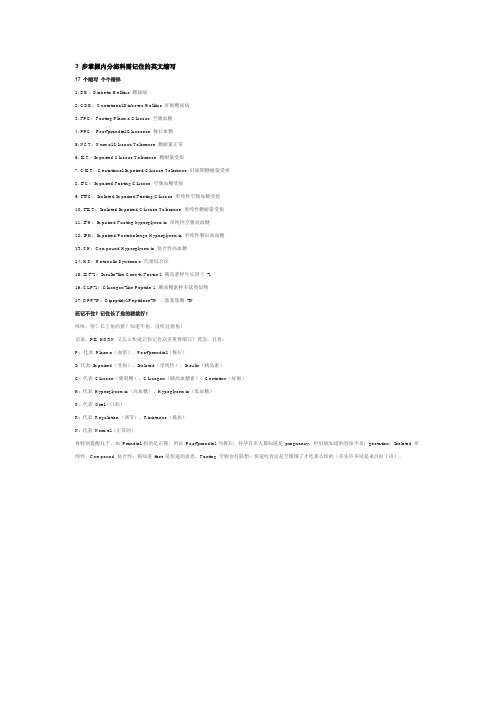
3 步掌握内分泌科需记住的英文缩写17 个缩写个个精悍1. DM:Diabetic Mellitus 糖尿病2. GDM:Gestational Diabetes Mellitus 妊娠糖尿病3. FPG:Fasting Plasma Glucose 空腹血糖4. PPG:Post-prandial Glucosese 餐后血糖5. NGT:Normal Glucose Tolerance 糖耐量正常6. IGT:Impaired Glucose Tolerance 糖耐量受损7. GIGT:Gestational Impaired Glucose Tolerance 妊娠期糖耐量受损8. IFG:Impaired Fasting Glucose 空腹血糖受损9. I-IFG:Isolated Impaired Fasting Glucose 单纯性空腹血糖受损10. I-IGT:Isolated Impaired Glucose Tolerance 单纯性糖耐量受损11. IFH:Impaired Fasting hyperglycemia 单纯性空腹高血糖12. IPH:Impaired Postchalenge Hyperglycemia 单纯性餐后高血糖13. CH:Compound Hyperglycemia 复合性高血糖14. MS:Metabolic Syndrome 代谢综合征15. IGF-1:Insulin-like Growth Factor 1 胰岛素样生长因子-116. GLP-1:Glucagon-like Peptide 1 胰高糖素样多肽类似物17. DPP-IV:Dipeptidyl Peptidase-IV 二肽基肽酶-IV还记不住?记住长了角的猪就行!咳咳,啥?长了角的猪?知道牛角,没听过猪角!话说,PIG HORN 又怎么快速让你记住众多重要缩写?莫急,且看:P:代表Plasma(血浆)、Post-prandial(餐后)I: 代表Impaired(受损)、Isolated(单纯性)、Insulin(胰岛素)G: 代表Glucose(葡萄糖)、Glucagon(胰高血糖素)、Gestation(妊娠)H: 代表Hyperglycemia(高血糖)、Hypoglycemia(低血糖)O: 代表Oral(口的)R: 代表Regulation(调节)、Risistance(抵抗)N: 代表Normal(正常的)再特别提醒几个,如Prandial 指的是正餐,所以Post-prandial 为餐后;怀孕许多人都知道是pregnancy,但妊娠知道的恐怕不多:gestation;Isolated 单纯性、Compound 复合性;都知道fast 是快速的意思,Fasting 空腹也好联想:快速吃肯定是空腹饿了才吃那么快的(其实许多词是来自拉丁语)。
代谢综合症的诊断标准
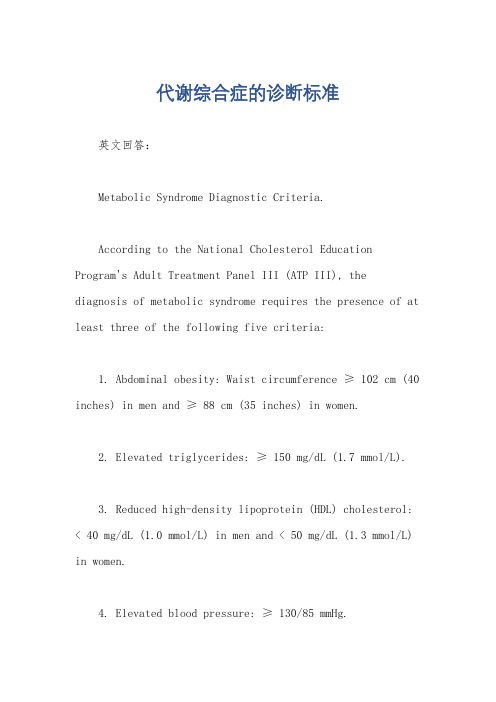
代谢综合症的诊断标准英文回答:Metabolic Syndrome Diagnostic Criteria.According to the National Cholesterol Education Program's Adult Treatment Panel III (ATP III), the diagnosis of metabolic syndrome requires the presence of at least three of the following five criteria:1. Abdominal obesity: Waist circumference ≥ 102 cm (40 inches) in men and ≥ 88 cm (35 inches) in women.2. Elevated triglycerides: ≥ 150 mg/dL (1.7 mmol/L).3. Reduced high-density lipoprotein (HDL) cholesterol: < 40 mg/dL (1.0 mmol/L) in men and < 50 mg/dL (1.3 mmol/L) in women.4. E levated blood pressure: ≥ 130/85 mmHg.5. Elevated fasting glucose: ≥ 100 mg/dL (5.6 mmol/L).中文回答:代谢综合征诊断标准。
根据全国胆固醇教育计划的成人治疗小组 III(ATP III),代谢综合征的诊断需要满足以下五项标准中的至少三项:1. 腹型肥胖,男性腰围≥102厘米(40英寸),女性腰围≥88厘米(35英寸)。
2. 甘油三酯升高,≥150毫克/分升(1.7毫摩尔/升)。
3. 高密度脂蛋白(HDL)胆固醇降低,男性<40毫克/分升(1.0毫摩尔/升),女性<50毫克/分升(1.3毫摩尔/升)。
肥胖有关的名词解释

肥胖有关的名词解释肥胖是一个日益普遍的健康问题,尤其在发达国家尤为突出。
不论是影响个体还是社会层面,肥胖都带来了许多负面影响。
在这篇文章中,我们将从不同的角度解释肥胖相关的名词,并深入探讨肥胖的原因、健康影响以及应对策略。
一、体重指数(BMI)体重指数,简称BMI(Body Mass Index),是计算个体体重与身高之间关系的一种常用方法。
公式为体重(公斤)除以身高(米)的平方。
通过BMI,我们可以初步评估个体是否超重或肥胖。
一般来说,BMI在18.5以下被视为体重过低,18.5-24.9为正常体重,25-29.9为超重,30及以上则表示肥胖。
二、代谢综合征代谢综合征(Metabolic Syndrome)是一组疾病风险因素的聚集体,包括腹部肥胖、高血压、高血糖、高血脂等。
这些因素一起增加了心血管疾病、糖尿病等慢性疾病的风险。
肥胖是代谢综合征的主要诱因之一,特别是腹部肥胖。
减轻体重、改善饮食和运动习惯是预防和治疗代谢综合征的重要措施。
三、内脏脂肪内脏脂肪是指位于腹腔内围绕主要脏器,如肝脏、胃、肠和肾脏等周围的脂肪。
与皮下脂肪相比,内脏脂肪更具危险性,因为它可以产生更多的有害物质,并与许多健康问题,如心脏病和糖尿病的风险增加,存在密切关联。
肥胖者往往携带较多的内脏脂肪,因此减少内脏脂肪含量对于改善健康至关重要。
四、肥胖基因肥胖基因是指影响个体体重调节和脂肪代谢的遗传因素。
研究表明,遗传因素在肥胖的发生中起到了一定的作用。
然而,环境和生活方式因素同样也对肥胖的产生起到重要作用。
尽管携带肥胖基因可能会增加患肥胖的风险,但通过采取健康的饮食和运动习惯,肥胖基因并不是不可战胜的因素。
五、脂肪酸代谢紊乱脂肪酸代谢紊乱是肥胖所引起的一个常见问题。
肥胖者体内脂肪过多,导致脂肪细胞释放过多的脂肪酸进入血液循环。
这些脂肪酸在机体内堆积,导致细胞对胰岛素的耐受性下降,进而引发糖尿病。
此外,脂肪酸代谢紊乱还与慢性炎症等病理过程紧密相关。
糖制品的坏处作文英语

糖制品的坏处作文英语英文回答:Detrimental Effects of Sugar Consumption.Sugar, a ubiquitous ingredient in countless processed foods and beverages, has become an intrinsic part of our modern diets. While it may provide temporary satisfaction and energy, excessive sugar consumption can have detrimental effects on both our physical and mental health.1. Weight Gain and Obesity:Sugar is a high-calorie food source that provideslittle nutritional value. Consuming sugary foods and drinks leads to excess calorie intake, which can promote weight gain and increase the risk of obesity. Obesity is a major risk factor for a range of chronic diseases, including cardiovascular disease, diabetes, and certain types of cancer.2. Dental Health:Sugar is a major contributor to tooth decay. When bacteria in the mouth break down sugar, they produce acids that erode tooth enamel and lead to cavities. Frequent consumption of sugary foods and drinks increases the likelihood of developing dental problems, including cavities, gum disease, and tooth loss.3. Diabetes:Excessive sugar intake can impair the body's ability to regulate blood sugar levels. Over time, this can lead tothe development of type 2 diabetes, a chronic conditionthat can damage blood vessels, nerves, and organs. Diabetes increases the risk of heart disease, stroke, kidney failure, blindness, and amputation.4. Cardiovascular Disease:Sugar consumption has been linked to an increased riskof cardiovascular disease, including heart attack and stroke. High blood sugar levels can damage blood vessels, leading to inflammation, plaque buildup, and narrowing of the arteries. This can restrict blood flow to the heart and brain, increasing the risk of cardiovascular events.5. Metabolic Syndrome:Metabolic syndrome is a group of conditions that includes high blood sugar, obesity, high blood pressure, and abnormal cholesterol levels. Sugar consumption can exacerbate these conditions, increasing the risk of developing cardiovascular disease, diabetes, and other health problems.6. Mental Health:While sugar may provide a temporary boost in mood, excessive consumption can have negative effects on mental health. Studies have linked high sugar intake to increased risk of anxiety, depression, and other mental health disorders. Sugar can disrupt the brain's reward pathways,leading to cravings and addictive behaviors.Conclusion:Excessive sugar consumption is a major public health concern. It contributes to a range of health problems, including weight gain, dental health issues, diabetes, cardiovascular disease, metabolic syndrome, and mental health disorders. Limiting sugar intake is essential for maintaining good health and reducing the risk of chronic diseases.中文回答:糖制品的危害。
关于甜食的危害英语作文
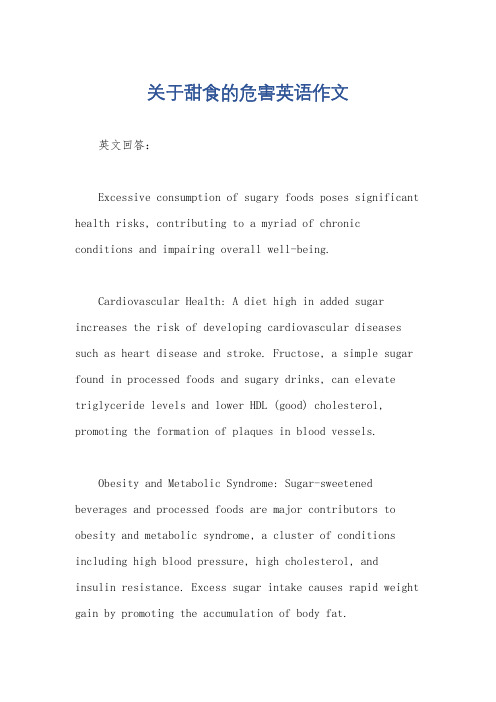
关于甜食的危害英语作文英文回答:Excessive consumption of sugary foods poses significant health risks, contributing to a myriad of chronic conditions and impairing overall well-being.Cardiovascular Health: A diet high in added sugar increases the risk of developing cardiovascular diseases such as heart disease and stroke. Fructose, a simple sugar found in processed foods and sugary drinks, can elevate triglyceride levels and lower HDL (good) cholesterol, promoting the formation of plaques in blood vessels.Obesity and Metabolic Syndrome: Sugar-sweetened beverages and processed foods are major contributors to obesity and metabolic syndrome, a cluster of conditions including high blood pressure, high cholesterol, andinsulin resistance. Excess sugar intake causes rapid weight gain by promoting the accumulation of body fat.Type 2 Diabetes: A chronic metabolic disorder, type 2 diabetes results from the body's inability to effectively use insulin, which regulates blood sugar levels. Excessive sugar consumption overworks the pancreas, leading to insulin resistance and ultimately, diabetes.Tooth Decay: Sugary foods and drinks provide a feast for oral bacteria, which produce acids that erode tooth enamel and cause cavities. Frequent consumption of these foods increases the risk of dental problems, including tooth decay and gum disease.Mood Swings and Behavior: Studies have linked sugar intake to fluctuations in blood sugar levels, which can contribute to mood swings, irritability, and fatigue. Excess sugar consumption has also been associated with an increased risk of anxiety and depression.Cancer: Emerging research suggests a possible link between high sugar intake and an increased risk of certain types of cancer, such as colon and breast cancer. Whilemore studies are needed to establish causality, the association warrants further investigation.Cognitive Decline: Some studies have shown that excessive sugar consumption may impair cognitive function and increase the risk of dementia in later life. The mechanisms underlying this association are not fully understood but may involve oxidative stress and inflammation.Nutrient Displacement: Sugary foods and drinks often provide empty calories, displacing nutrient-rich foods from the diet. Excessive sugar intake can lead to deficienciesin essential vitamins, minerals, and antioxidants, compromising overall health and well-being.中文回答:甜食的危害。
合并寻常型银屑病和假性黑棘皮病的肥胖儿童代谢综合征一例

合并寻常型银屑病和假性黑棘皮病的肥胖儿童代谢综合征一例孙勇虎㊀张福仁㊀㊀代谢综合征(MetabolicSyndrome)是包括中心型肥胖㊁高血压㊁高血糖或胰岛素抵抗㊁低HDL-C和高血脂等多种异常代谢指标在内的一种综合征ꎬ是心血管病和糖尿病等疾病的风险因素ꎮ在皮肤科中ꎬ代谢综合征与多种皮肤疾病显著相关ꎬ包括银屑病㊁黑棘皮病㊁黄瘤病㊁痤疮和化脓性汗腺炎等ꎮ我国流行病学数据表明银屑病合并代谢综合征的比例为29%[1]ꎬ而黑棘皮病合并代谢综合征在青少年肥胖患者中的比例也高达40%[2]ꎮ目前ꎬ三者同时并发的报道尚未见中文文献报道ꎬ现将我们在门诊近期诊断的1例报道如下ꎮ㊀㊀临床资料㊀患儿ꎬ女ꎬ11岁ꎮ因 全身红斑鳞屑5年ꎬ皮肤色素增加3年 来我院就诊ꎮ患儿5年前无明显诱因于躯干出现鳞屑性丘疹㊁斑块ꎬ渐加重累及头面部ꎬ3年前颈项部㊁腋窝和腹股沟等皱褶部位出现色素沉着ꎬ并逐渐加重ꎮ在外院曾按 银屑病 湿疹 等不规则治疗ꎬ病情时有反复ꎮ㊀㊀体格检查:肥胖体型ꎬ身高153cmꎬ体重72kgꎬ腰围77cmꎬBMI=30kg/m2ꎬ全身系统检查未及明显异常ꎮ皮肤科检查:颈项部㊁腋窝和腹股沟见黑色或褐色增生性皮损ꎬ部分呈天鹅绒样外观ꎮ头面㊁四肢和躯干泛发红色丘疹和斑块ꎬ上覆银色鳞屑ꎬ散在少量抓痕ꎬ部分鳞屑性红斑丘疹位于色素沉着部位ꎮ实验室检查:血㊁尿常规正常ꎬ生化常规:空腹血糖5.46mmol/L(3.9~6.1mmol/L)ꎬ尿酸UA675umol/L(137~363μmol/L)ꎬ甘油三酯TG6.53mmol/L(0.56~1.7mmol/L)ꎬ高密度脂蛋白胆固醇HDL-C0.50mmol/L(0.78~2mmol/L)ꎬ低密度脂蛋白胆固醇LDL1.24mmol/L(2.27~3.36mmol/L)ꎬ余化验结果正常ꎮ诊断:肥胖儿童代谢综合征伴发寻常型银屑病及假性黑棘皮病ꎮ治疗:给予新体卡松10mg日3次口服ꎬ外用滋润护肤霜ꎬ并嘱其控制饮食㊁加强体育锻炼ꎬ至内分泌科进一步治疗ꎮ图1㊀a:面部㊁头皮及上肢散在鳞屑性丘疹和斑块ꎻ双侧腋窝黑褐色增生性皮损ꎬ呈天鹅绒样外观ꎻb:颈后见黑褐色增生性皮损ꎻc㊁d:四肢散在鳞屑性丘疹及斑块ꎬ少量抓痕㊀㊀讨论㊀肥胖是儿童发病率最高的慢性疾病ꎬ与代谢综合征密切相关ꎮ根据2005年国家调查获得的0~18岁我国儿童青少年BMI的参考值及生长曲线[3]ꎬ11岁女童的肥胖界点BMI指数为22.7kg/m2ꎬ本例患儿BMI指数远大于此指数ꎬ为肥胖儿童ꎮ根据国际糖尿病联盟(IDF)关于代谢综合征的全球共识ꎬ尽管其血糖水平正常ꎬ但因其中心型肥胖㊁高TG水平和低HDL水平ꎬ符合代谢综合征的诊断ꎮ㊀㊀由于Th17和Th1通路与银屑病的发病高度相关ꎬ有研究认为通路的失调和炎症细胞激活与肥胖作者单位:山东省皮肤病性病防治研究所ꎬ山东济南ꎬ250022通信作者:张福仁ꎬE-mail:zhangfuren@hotmail.com和胰岛素抵抗相关[4ꎬ5]ꎮ多个大规模Meta分析表明了银屑病患者中代谢综合征的高流行率[6ꎬ7]ꎮ在中国ꎬ蔡云飞等[1]的大规模Meta分析研究表明ꎬ银屑病中代谢综合征的发生率为29%ꎬ与亚洲其他国家结果类似[7]ꎬ但低于北非[8]和美国[9]的调查研究ꎮ关于黑棘皮病与代谢综合征的相关性研究远少于银屑病与代谢综合征相关性的研究ꎬ2014年ꎬTeslime等调查了250例肥胖女性患者ꎬ发现黑棘皮病组的代谢综合征患病率(60%)显著高于无黑棘皮病组(37.6%)[10]ꎮ另外ꎬ儿童高血压㊁胰岛素抵抗和脂代谢异常等代谢综合征的临床表现也与黑棘皮病的发生显著相关[11]ꎮ尽管银屑病与黑棘皮病临床较为常见ꎬ检索数据44ChinJLeprSkinDis.Jan2019ꎬVol.35ꎬNo.1库(Pubmedꎬ知网和万方)发现仅有一篇英文文献报道肥胖儿童中同时存在银屑病和黑棘皮病[12]ꎬ中文文献尚未见报道ꎮ随着生活水平的提高ꎬ肥胖和代谢综合征越来越多见于儿童ꎬ皮肤科查体因其无创和直观的特点ꎬ认识到皮肤疾病与代谢综合征的相关性ꎬ将银屑病和黑棘皮病作为提示是否合并代谢综合征的标志ꎬ进而对患儿进行早期干预和治疗ꎬ对抑制疾病的进展具有重要作用ꎮ参考文献[1]蔡云飞ꎬ吴严ꎬ高兴华.中国银屑病患者合并代谢综合征患病率的Meta分析[J].临床和实验医学杂志ꎬ2016ꎬ15(7):639-642.[2]刘磊ꎬ古丽鲜 阿布都热依木ꎬ魏惠琴.青少年肥胖合并良性黑棘皮病与代谢综合征[J].新疆医学ꎬ2014ꎬ44(6):12-15.[3]李辉ꎬ季成叶ꎬ宗心男ꎬ等.中国0~18岁儿童㊁青少年体块指数的生长曲线[J].中华儿科杂志2009ꎬ47(7):493-498.[4]GoldenJBꎬMcCormickTSꎬWardNL.IL-17inpsoriasis:implicationsfortherapyandcardiovascularco-morbidities[J].Cytokineꎬ2013ꎬ62:195-201.[5]ArmstrongAWꎬHarskampCTꎬArmstrongEJ.Psoriasisandmetabolicsyndrome:asystematicreviewandmeta-analysisofobservationalstudies[J].JAmAcadDermatolꎬ2013ꎬ68:654-662.[6]Rodríguez-ZúñigaMJMꎬCortez-FrancoFꎬQuijano-GomeroE.Associationofpsoriasisandmetabolicsyndromeinlatina ̄merica:Asystematicreviewandmeta-analysis[J].ActasDermosifiliogrꎬ2017ꎬ108:326-334.[7]TakahashiHꎬTakahashiIꎬHonmaMꎬetal.PrevalenceofmetabolicsyndromeinJapanesepsoriasispatients[J].JDer ̄matologicalScienceꎬ2010ꎬ57:143-144.[8]AsmiElMꎬZidiWꎬZayaniYꎬetal.MetabolicsyndromeinTunisianpsoriaticpatients:prevalenceanddeterminants[J].JEurAcadDermatolVenereolꎬ2011ꎬ25:705-709. [9]LoveTJꎬQureshiAAꎬKarlsonEWꎬetal.Prevalenceofthemetabolicsyndromeinpsoriasis:resultsfromthenationalhealthandnutritionexaminationsurveyꎬ2003-2006[J].ArchDermatolꎬ2011ꎬ147:419-424.[10]AyazTꎬBaydurŞahinSꎬSahinoZ.Relationofacanthosisnigricanstometabolicsyndromeinoverweightandobesewomen[J].MetabSyndrRelatDisordꎬ2014ꎬ12(6):320-323.[11]BrickmanWJꎬHuangJꎬSilvermanBLꎬetal.Acanthosisnigricansidentifiesyouthathighriskformetabolicabnor ̄malities[J].JPediatrꎬ2010ꎬ156:87-92.[12]DeklotzCMCꎬEshaghKꎬKrakowskiAC.Psoriaticplaques koebnerizing toareasofacanthosisnigricansinanobesefemale:cluestoacommonpathway?[J].JClinAesthetDermatolꎬ2014ꎬ7:40-41.(收稿:2017-08-08㊀修回:2017-09-25)以臀部结节为主要表现的疥疮一例胡艺凡㊀许㊀辉㊀史玉玲㊀㊀临床资料㊀患者ꎬ女ꎬ58岁ꎮ臀部㊁腹部㊁双下肢皮疹伴全身皮肤瘙痒2个月ꎮ患者2个月前自觉全身瘙痒ꎬ于腹部㊁双下肢㊁臀部逐渐出现红色结节ꎬ就诊于外院门诊ꎬ诊断为 湿疹 ꎬ予以糖皮质激素外涂及依巴斯汀10mg每日一次口服ꎬ瘙痒无明显缓解ꎬ结节变化不明显ꎮ今为求进一步诊治ꎬ遂至我科门诊就诊ꎮ追问病史:患者曾去养老院工作ꎬ同院老人有疥疮患者ꎬ近亲属无类似症状ꎮ患者既往㊁家族史无特殊ꎮ体格检查:一般情况好ꎬ系统检查无特殊ꎮ皮肤科检查:腹部㊁双大腿伸侧和内侧㊁臀部可见红斑㊁作者单位:上海市第十人民医院皮肤科ꎬ上海ꎬ200072通信作者:史玉玲ꎬE-mail:shiyuling1973@126.com结节ꎬ臀部部分结节融合ꎬ外阴部位未见皮疹ꎮ手指侧缘可见米粒大丘疹㊁丘疱疹伴脱屑ꎬ但是指缝皮疹不明显(图1~4)ꎮ右臀部结节组织病理示:角化过度ꎬ角化不全ꎬ棘层肥厚ꎬ海绵水肿形成ꎬ真皮全层血管周围混合炎细胞浸润ꎬ以嗜酸粒细胞㊁淋巴细胞为主ꎬ皮下脂肪间可见多核巨细胞ꎮ抗酸染色(-)ꎮ病理符合疥疮结节改变(图5)ꎮ取多处皮损皮肤刮片检查可见疥虫及虫卵ꎮ诊断:疥疮ꎮ治疗:10%硫磺软膏每日2次全身外涂ꎬ连续3天用药ꎬ停药4天ꎮ共治疗2个疗程ꎮ臀部结节联合糠酸莫米松外涂ꎮ治疗2周后症状明显好转ꎬ进一步治疗后皮疹全部消退ꎮ54中国麻风皮肤病杂志㊀2019年1月第35卷第1期。
肥胖症的英语词组
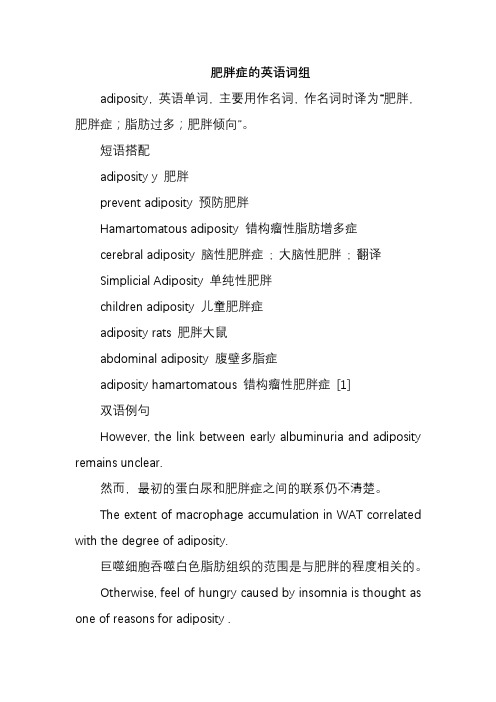
肥胖症的英语词组
adiposity,英语单词,主要用作名词,作名词时译为“肥胖,肥胖症;脂肪过多;肥胖倾向”。
短语搭配
adiposity y 肥胖
prevent adiposity 预防肥胖
Hamartomatous adiposity 错构瘤性脂肪增多症
cerebral adiposity 脑性肥胖症; 大脑性肥胖; 翻译
Simplicial Adiposity 单纯性肥胖
children adiposity 儿童肥胖症
adiposity rats 肥胖大鼠
abdominal adiposity 腹壁多脂症
adiposity hamartomatous 错构瘤性肥胖症[1]
双语例句
However, the link between early albuminuria and adiposity remains unclear.
然而,最初的蛋白尿和肥胖症之间的联系仍不清楚。
The extent of macrophage accumulation in WAT correlated with the degree of adiposity.
巨噬细胞吞噬白色脂肪组织的范围是与肥胖的程度相关的。
Otherwise, feel of hungry caused by insomnia is thought as one of reasons for adiposity .
反之,由于失眠而导致的饥饿感,以被认为是引发肥胖的原因之一。
肥胖用英语怎么说

肥胖用英语怎么说肥胖症是一种由多种因素引起的慢性代谢性疾病,以体内脂肪细胞的体积和细胞数增加致体脂占体重的百分比异常增高并在某些局部过多沉积脂肪为特点。
单纯性肥胖患者全身脂肪分布比较均匀,没有内分泌紊乱现象,也无代谢障碍性疾病,其家族往往有肥胖病史。
那么你知道肥胖用英语怎么说吗?下面来学习一下吧。
肥胖英语说法1:fat肥胖英语说法2:adiposity肥胖英语说法3:obesity肥胖的英语例句:他因为缺少锻炼而日见肥胖肌肉松弛。
He's getting fat and flabby because he doesn't have enough exercise.她取笑他肥胖。
She made a crack about his fatness.那件紧身套头毛衣反更突出了他那肥胖的肚子。
The tight jumper only accentuated his fat stomach.西方国家很多人都有过度肥胖的问题。
Obesity is a problem for many people in western countries.由于肥胖,大夫叫我停止吃肉。
The doctor told me to cut out meat for my fat.肥胖。
比如肥胖确实有害健康Obesity is a real health hazard.绿茶防止肥胖病由停止葡萄糖的运动在肥胖细胞里。
Green tea prevents obesity by stopping the movement of glucose in fat cells.网络社交游戏能帮助人们对抗肥胖吗?Can an online social game help fight obesity?肥胖会增加高血压和中风发作的几率。
Obesity correlates with increased risk for hypertension and stroke.肥胖是引发多种疾病的重要因素。
儿科学名称英文简写
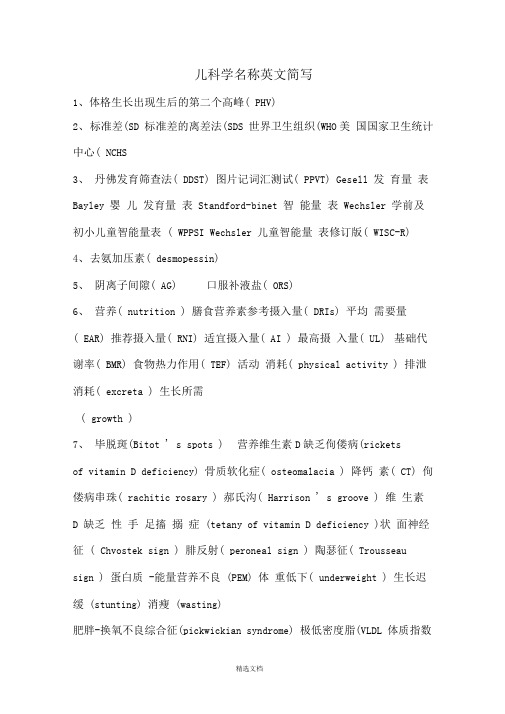
儿科学名称英文简写1、体格生长出现生后的第二个高峰( PHV)2、标准差(SD 标准差的离差法(SDS 世界卫生组织(WHO美国国家卫生统计中心( NCHS3、丹佛发育筛查法( DDST) 图片记词汇测试( PPVT) Gesell 发育量表Bayley 婴儿发育量表Standford-binet 智能量表Wechsler 学前及初小儿童智能量表 ( WPPSI Wechsler 儿童智能量表修订版( WISC-R)4、去氨加压素( desmopessin)5、阴离子间隙( AG) 口服补液盐( ORS)6、营养( nutrition ) 膳食营养素参考摄入量( DRIs) 平均需要量( EAR) 推荐摄入量( RNI) 适宜摄入量( AI ) 最高摄入量( UL) 基础代谢率( BMR) 食物热力作用( TEF) 活动消耗( physical activity ) 排泄消耗( excreta ) 生长所需( growth )7、毕脱斑(Bitot ' s spots ) 营养维生素D缺乏佝偻病(ricketsof vitamin D deficiency) 骨质软化症( osteomalacia ) 降钙素( CT) 佝偻病串珠( rachitic rosary ) 郝氏沟( Harrison ' s groove ) 维生素D 缺乏性手足搐搦症(tetany of vitamin D deficiency )状面神经征 ( Chvostek sign ) 腓反射( peroneal sign ) 陶瑟征( Trousseau sign ) 蛋白质-能量营养不良(PEM) 体重低下( underweight ) 生长迟缓(stunting) 消瘦(wasting)肥胖-换氧不良综合征(pickwickian syndrome) 极低密度脂(VLDL 体质指数( BMI) ptader-Willi 综合征Laurence-Moon-Biedl 综合征肥胖生殖无能症(Frohlich syndrome) 肠病性肢端皮炎(acrodermatitis enteropathica) 餐后血清锌浓度( PICR)碘缺乏病( IDD) 食盐加碘( USI)8、痤疮( acne) 遗精(spermatorrhoea) 手淫( masturbarion ) 心理社会发育障碍(disturbed psychosocial development) 焦虑症(anxiety disorder ) 抑郁症(depression) 神经性厌食症(anorexia nervosa) 神经性贪食症(bulimia nervosa) 物质滥用( substance abuse ) 伤害(injury)9、胎龄( GA) 出生体重( BW) 小于胎龄( SGA) 高危儿( high risl infant ) 经皮氧分压( Tc-Po2) 二氧化碳分压(TcPCO2) 脉搏氧饱和度监护( TcSO2) 新生儿重症监护室 ( NICU) 慢性肺疾病 ( CLD) 新生儿持续性肺动脉高压( PPHN) 持续胎儿循环( PFC) 小于胎龄儿(SGA 宫内生长迟缓(IUGR 胰岛素样生长因子(IGFs)胰岛素样生长因子结合蛋白( IGFBPs) 大于胎龄儿( LGA) 新生儿窒息( asphyxia of newborn ) 原发性呼吸暂停(primary apnea) 继发性呼吸暂停(secondary apnea) 美国儿科学会( AAP) 妇科学会( ACOG 纳洛酮( naloxone ) 新生儿缺血缺氧性脑病( HIE) 磁共振成像(MR)氢质子磙共振波谱(1HMRS 胚胎生发基质(GM 脑室周围-脑室内出血( PVH-IVH 原发性蛛网膜下腔出血( SAH 脑实质出血( IPH 硬膜下出血( SDH 小脑出血( CH 胎粪吸入综合征(MAS新生儿持续性肺动脉高压(PPHN 动脉氧分压(PAO)一氧化氮吸入(Ino )体外膜肺(ECM)O 新生儿呼吸窘迫综合征(RDS)肺透明膜病(HMD)肺表面活性物质(PS)磷脂酰胆碱、卵磷脂(PC)磷脂甘油(PG)表面活性物质蛋白(SP)功能残气量(FRC)糖尿病母亲所娩的婴儿(IDM)持续气道正压(CPAP)常频机械通气(CMV)吸气峰压(PIP)慢性肺疾病(CLD)人造肺扩张剂(ALEC)Crigler-Najjar 综合征Gilbert 综合征Lucey-Driscoll 综合征Dubin-Johnson 综合征新生儿溶血病(HDN)直接抗人球蛋白试验(Coombs试验)风疹病毒(RV 巨细胞病毒(CMV 单纯疱疹病毒(HSV) B 组溶血性链球菌(GBS)粒细胞-集落刺激因子(G-CSF)白介素8(IL-8 )对流免疫电泳(CIE)乳胶颗粒凝集(LA)限制性内切酶分析(REA)聚合酶链反应(PCR) C 反应蛋白(CRP 触珠蛋白(HP a 1-酸性糖蛋白(a 1-AG) a 1-抗胰蛋白(a 1-AT)人类巨细胞病毒(HCMV 沙眼衣原体(CT)直接荧光抗体(DFA)楔形齿(Hutchinson 齿)性病实验试剂盒(VDRL)荧光螺旋体抗体吸附试验(FTA-ABS)新生儿坏死性小肠结肠炎(NEC)新生儿出血症(HDN)10、21-三体综合征(Down's 综合征)先天性卵巢发育不全综合征(Turner 综合征)先天性睾丸发育不全综合征(Klinefelter 综合征)遗传性代谢病(IEM )苯丙酮尿症(PKU 苯丙氨酸(Phe)肝豆状核变性(HLD K-F 环糖原累积病(GSD 黏多糖病(MPS硫酸角质素(KS 硫酸软骨素(CS 透明质酸(HA 硫酸类肝素(HS 硫酸皮肤素(DS 免疫缺陷病(ID)原发性免疫缺陷病(PID)继发性免疫缺陷病(SID)联合免疫缺陷病(CID)严重联合免疫缺陷病(SCID)X-连锁无丙种球蛋白血症(XLA 常见变异免疫缺陷病(CVID)湿疹血小板减少伴免疫缺陷(WAS共济失调毛细血管扩张综合征(AT 胸腺发育不全(DA 白细胞黏附分子缺陷(LAD LADI为缺陷者慢性肉芽肿病(CGD 普通变异型免疫缺陷病(CVID)移植物抗宿主反应(GVHR 抗链球菌溶血素0(ASO 迟发皮肤过敏试验(DCH 四唑氮兰染料(NBT)绒毛膜标本酶(ADA 丙种球蛋白(IVIG)高效价免疫血清球蛋白(SIG)腺苷脱氨酶(ADA 继发性免疫缺陷病(SID)抗链球菌激酶(ASK 幼年特发性关节炎(JIA)幼年类风湿性性关节炎(JRA 幼年慢性关节炎(JCA 幼年型关节炎(JA)类风湿因子(RF 抗核抗体(ANA 非甾体类抗炎药(NSAIDS 缓解病情抗风湿药(DMARDs 甲氨蝶呤(MTX 环磷酰胺(CTX 亨-舒综合征(HSP 川崎病(KD 亚急性硬化性全脑炎(SSPE 水痘-带状疱疹病毒(VZV单纯疱疹病毒(HSV 传染性单核细胞增多症(IM )膜抗原(MA 全身炎症反应综合征(SIRS)多器官功能衰竭(M0F 聚合酶链反应(PCR 代偿性抗炎反应综合征(CARS组织相容性抗原(HLA11、胃食管反流(GER 食管下端括约肌(LES 胃食管反流病(GERD San difer综合征不耐热肠毒草素(LT)耐热肠毒草素(ST)脑-肝-肾综合征(Zellweger' s综合征)急性上呼吸道感染(AUR )鼻病毒(RV呼吸道合胞病毒(RSV腺病毒(ADV 降钙素原(PCT 非肾上腺素能非胆碱能(NANC 气道高反应性(AHR 抗利尿激素异常分泌综合征(SIADH 革兰阴性杆菌肺炎(GNBP 先心病(CHD 肺动脉瓣狭窄(PS)法洛四联症(TOF 完全性大动脉转位(c-TGA 生理纠正手术(senning 或Mustard 手术解剖纠正手术(switch 手术12、肾小球滤过率(GFR 急性肾小球肾炎(AGN 急进性肾小球肾炎(RPGN 肾病综合征(NS 遗传性进行性肾炎(Alport 甲- 膑综合征(遗传性指甲骨关节发育不良Fanconi 综合征(近端肾小管复合性功能缺陷疾病数字减影血管造影(DSA 血管紧张素转换酶抑制剂(ACEI 弥漫性系膜硬化(DMS 乙型肝炎病毒相关性肾炎(HBV-GN 泌尿道感染(UTI 膀胱输尿管反流(VUR 亚硝酸盐试纸条试验(Griess 试验反流性肾病(RN 静脉肾盂造影(IVP)DMSA扫描技术(同位素静态肾扫描)肾小管酸中毒(RTA远端肾小管酸中毒(dRTA 近端肾小管酸中毒(pRTA 复方枸椽酸溶液(shohl 液溶血尿毒综合征(HUS 乳酸脱氢酶(LDH 阵发性睡眠性血红蛋白尿(PNH 急性肾衰竭(ARF 急性肾小管坏死(ATN 缺铁性贫血(IDA 总铁结合力(TIBC 转铁蛋白饱和度(TS)遗传性球蛋白红细胞增多症(HS 硝基四氮唑蓝(NBT 先天性非球形细胞性溶血性贫血(CNSHA 重型B地中海贫血(Cooley贫血)中间型a地中海贫血(血红蛋白H病)重型a地中海贫血(Hb Bart's 胎儿水肿综合征特发性(自身免疫性血小板减少性紫癜(ITP)抗-D免疫球蛋白(抗Rh球蛋白)1-脱氧精氨酸加压素(DDAVP 血浆鱼精蛋白副凝试验(3P试验)凝血时间(TT)急性淋巴细胞白血病(ALL)急性非淋巴细胞白血病(ANLL 人类T细胞白血病病毒(HTLV 先天性远端毛细血管扩张性红斑症(Bloom 综合征)高危型急性淋巴细胞白血病(HR-ALL)中危型急性淋巴细胞白血病(MR-ALL)低危型急性淋巴细胞白血病(SR-ALL)甲氨蝶呤-四氢叶酸钙(HDMTX-CF 中枢神经系统白血病(CNSL)睾丸白血病(TL)郎格汉斯细胞增生症(LCH)13、脑电图(EEG)婴儿痉挛(West 综合征)Lennox-Gastaut 综合征(LGS)全面性癫痫伴热性惊厥附加症(GEFS+ 癫痫持续状态(SE梦游症(MRE深睡期障碍)Reye综合征(急性弥漫性脑水肿和肝脏为主的内脏脂肪变性)吉兰-巴雷综合征(GBS)急性炎症性脱髓鞘性多神经病(AIDP)急性运动轴索型神经病(AMAN 急性运动感觉轴索型神经病(AMSAN 重症肌无力(MG)磷酸肌酸激酶(CK)生长激素缺乏症(GHD)人生长激素(GH)生长激素结合蛋白(GHBP 遗传性生长激素缺乏(HGHD 胰岛素样生长因子(IGF-1)促性腺激素释放激素(GnRH 尿崩症(DI)抗利尿激素(ADH 精氨酸加压素(AVP下丘脑-垂体-性腺轴(HPGA 促性腺激素(Gn 黄体生成素(LH 卵泡刺激素(FSH 中枢性性早熟(CPP 先天性肾上腺皮质增生症(CAH 21- 羟化酶缺乏症(21-OHD 单纯男性化型(SV 失盐型(SW 非典型型(NC11 B -羟化酶缺乏症(11 B -OHD 3 (3 -羟类固醇脱氢酶缺乏症(3 B -HSD)17 a -羟化酶缺乏症(17-0HD 17-羟类固醇(17-0HCS17-酮类固醇(17-KS)17- 羟孕酮(17-OHP)糖尿病(DM)胰岛素依赖性糖尿病(IDDM 空腹血糖(FPG 胰岛素泵(DSH)14、心肺复苏(CPR)。
- 1、下载文档前请自行甄别文档内容的完整性,平台不提供额外的编辑、内容补充、找答案等附加服务。
- 2、"仅部分预览"的文档,不可在线预览部分如存在完整性等问题,可反馈申请退款(可完整预览的文档不适用该条件!)。
- 3、如文档侵犯您的权益,请联系客服反馈,我们会尽快为您处理(人工客服工作时间:9:00-18:30)。
IRS: AACE Criteria
Diagnosing Insulin Resistance Syndrome Is as Simple as 1 plus 2
Choose:
One Risk + Two Parameters
IRS: AACE Criteria – Risks (Choose 1)
Reaven G. Diabetes. 1988;37:1565-1607.
The Metabolic Syndrome: Current Perspective
Body Size BMI Central Adiposity
Insulin Resistance
+
Hyperinsulinemia
Obesity and Metabolic Syndrome
Steven M. Haffner, MD
Conceptual Framework for the Metabolic Syndrome
Environmental causes are responsible for the epidemic of the metabolic syndrome (NCEP)
Personal Dx of HTN, TGL, low HDL or CVD
Acanthosis nigricans
Polycystic ovarian syndrome (PCOS)
Nonalcoholic fatty liver disease (NAFLD) Cancer (obesity related)
n = 2,815 (age 25-64) – Both NCEP and WHO metabolic syndrome, 509 – NCEP alone, n=197 – WHO alone, n=199 12.7 year follow-up (229 deaths) Three populations considered – Overall population – No CVD at baseline – No CVD or diabetes at baseline (primary prevention)
–
Treatment:
reduce obesity and increase activity
Insulin resistance is the underlying cause of the metabolic syndrome (WHO)
–
Treatment:
a) reduce obesity and increase activity b) insulin sensitizers
WHO Metabolic Syndrome Definition 1999: Based on Clinical Criteria
Insulin resistance (type 2 diabetes, IFG, IGT)*
Plus any 2 of the following:
– – – – –
36%
40% 30% 20% 10% 0%
African American
28%
25% 21% 16%
26% 23% 20%
Men
Ford ES et al. JAMA 2002;287:356-359.
Women
Botnia Study
Prevalence of CHD in Patients with the Metabolic Syndrome
Metabolic Syndrome Increases Risk for CHD and Type 2 Diabetes
High LDL-C
Metabolic Syndrome Type 2 Diabetes
Coronary Heart Disease
Expert Panel on Detection, Evaluation, and Treatment of High Blood Cholesterol in Adults. JAMA 2001;285:2486-2497.
Defining Level
>102 cm (>40 in) >88 cm (>35 in) >150 mg/dL <40 mg/dL <50 mg/dL >130/>85 mm Hg >110 (>100)**mg/dL
** 2003 New ADA IFG criteria (Expert Panel…,Diabetes Care 26:3160-3167, 2003)
* The Expert Panel on Detection, Evaluation, and Treatment of High Blood Cholesterol in Adults. JAMA. 2001;285:2486-2497. **The Expert Committee on the Diagnosis and Classification of Diabetes Mellitus: Follow-up report on the diagnosis of diabetes mellitus. Diabetes Care 26:3160-3167, 2003
15
Cumulative Hazard, %
Cardiovascular Disease Mortality RR (95% CI), 3.55 (1.98–6.43)
10
Metabolic Syndrome:
YES
5
NO
0
0
2
4 6 8 Follow-up, year
10
12
Lakka HM et al. JAMA 2002;288:2709-2716.
Prevalence of the NCEP Metabolic Syndrome: NHANES III by Age
50% 40%
Men Women
24% 23%
44% 44%
Prevalence, %
30% 20% 10% 0%பைடு நூலகம்
8% 6%
20–70+ 20–29
30–39
40–49
50–59
The Metabolic Syndrome: Historical Perspective
1988: Syndrome X
Insulin Resistance
Glucose Intolerance
Hyperinsulinemia
TG
HDL-C
Hypertension
CORONARY HEART DISEASE
*Diagnosis is established when >3 of these risk factors are present
Risk Factor
Abdominal obesity† (Waist circumference‡) Men Women TG HDL-C Men Women Blood Pressure Fasting glucose
SNS activity Na retention Hypertension
CRP PAI-1 Fibrinogen
CORONARY HEART DISEASE
Adapted from Reaven G. Drugs. 1999;58 (suppl):19-20
ATP III: The Metabolic Syndrome*
IRS: AACE Criteria – Parameters (Choose 2)
Triglycerides >150 mg/dl
HDL cholesterol – Men <40 mg/dl – Women <50 mg/dl
Blood pressure >135/85 Blood glucose – 2-hour >140 mg/dl, OR – Fasting 110 – 125 mg/dl
No MS/No DM 54.2%
MS/No DM 28.7%
DM/No MS 2.3%
DM/MS 14.8%
Alexander CM et al. Diabetes 2003;52:1210-1214..
NCEP vs WHO Metabolic Syndrome in Relationship to CVD Mortality: San Antonio Heart Study
Elevated BP (>140/90 or drug Rx) Plasma TG >150 mg/dl HDL <35 mg/dl (men); <40 mg/dl (women) BMI >30 and/or W/H >0.9 (men), >0.85 (women) Urinary albumin >20 mg/min; Alb/Cr >30 mg/g
Glucose Metabolism
±
Uric Acid Metabolism
Dyslipidemia
Hemodynamic
Novel Risk Factors
Glucose intolerance
Uric acid Urinary uric acid clearance
TG PP lipemia HDL-C PHLA Small, dense LDL
